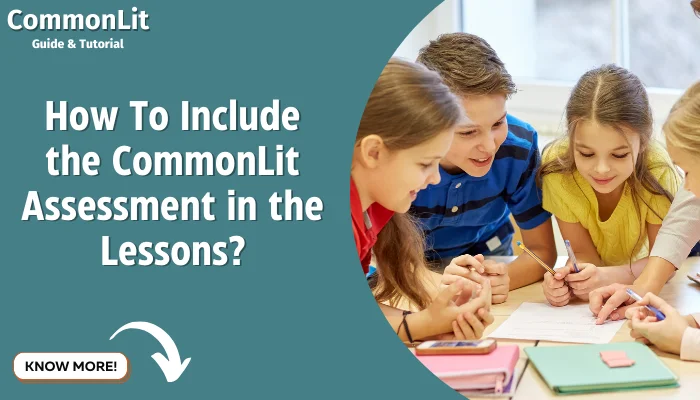CommonLit assessment is one of the indispensable tools within education, growing teachers’ confidence in tracking each student’s level of comprehension and the ability to read and understand literary works by students.

Approved passages are accompanied by rigorous questioning in order to ensure that the CommonLit assessment series engages students with only quality texts, engaging them in critical analysis of the materials for better performance.
The article outlines several features of the CommonLit assessment which are useful to teachers and students in enhancing the usability of the tool.

CommonLit Assessment: What It Is?
CommonLit assessment is one such method employed in an attempt to evaluate the students’ competency on the comprehension of materials read.
This is an evaluation tool that does not merely evaluate recall of information which is the bane of most tests. Therefore, students will be able to not only remember facts but synthesize them, make judgments, and apply them.
Features of the Assessment
- High-Quality Texts: The assessment comprises over extensive genres on the historically organized structure which consists of works of fiction and non-fiction, poetry, and socio-political documents amongst others.
- Rigorous Questioning: This portion is comprised of robust questioning in order to encourage every student during each assessment of the CommonLit. Most times these questions make students go deeper by making inferences, defining the central idea or theme, as well as the author’s intent.
- Compliance with Standards: A particular item or the assessment is based on the Common Core and such other legal requirements which have to be upheld in the United States classrooms.
Importance of the Assessment
Thus, the CommonLit assessment provides opportunities for the learners to develop their reading skills.
There is also preparation for further studies and employment opportunities, since the student’s attention is on comprehension skill acquisition rather than rote learning.
Furthermore, the information that the teachers obtain from the assessment series enables them to understand where students’ needs possibly lie and that helps in individual student learning in a timely way.
The Structure of CommonLit Assessment Series
The assessment series intends to establish an extensive view about the impact of reading on learners over a long period of time. This series consists of various tests focusing on different components of reading but with the same aim of thorough evaluation for students.
Components of the CommonLit Assessment Series
- Pre-Assessment: The first step in the assessment series is the pre-assessment which is commonly referred to as the pretest. This test is given at the beginning of the year and is aimed at testing how good students are at reading.
- Formative Assessments: As the academic year proceeds, students are subjected to a few formative assessments which form part of the assessment series, during that certain academic year. These tests are intended to assist teachers in understanding and evaluating the progress being made by learners in a way that can help learning. They are shorter and more targeted than the pre-assessment and post assessment.
- Post-Assessment: The post-assessment is administered at the end of the school year. It is a comprehensive test that evaluates the progress students have made in their reading abilities. The results of the post-assessment are compared to the pre-assessment to measure growth.
How Assessment Series Can Help?
The assessment series is beneficial for both the students and the officials in several ways:
- Tracking Progress: Since there are assessments to be done several times within a single year, the assessment series makes it possible for the teacher to track how the student’s skills develop over time. This information is very useful as it helps pinpoint improvements and the things that require more attention.
- Guiding Instruction: The analysis of the various features of the assessment series delivers results that are helpful in planning instruction. The assessment data helps teachers shift from one instructional approach to another and therefore assist students well in areas that they may be struggling.
- Ensuring Consistency: There is procedural organization in terms of examination and evaluation in the assessment series, and that helps re-evaluate the capability of students in a given period of time and even help reduce chances of bias or inconsistency in the assessments.
The CommonLit assessment series is very effective in measuring and improving the students’ reading habits. It assists both students and instructors by having regular assessments to show the overall development of the student throughout the year.
How to Prepare for the CommonLit Assessment?
As with all forms of assessment, proper preparation will enable better performance in the CommonLit assessment. It can always be very helpful for students to be aware of what to expect and how to tackle the test.
- Read Regularly: One area that seeks to improve students’ performance in the CommonLit assessment is the formation of sound reading habits. Read all types of books like novels, research books, poems so as to increase students’ comprehension capability.
- Practice Analyzing Texts: The students will be required to critically analyze the texts in the assessment. Use this activity to guide students on how to discern the central idea, themes, and the purpose of the author in the text they are reading.
- Answer Practice Questions: Students are usually more confident if they already have a clue on what types of questions will be asked in the assessment. Utilize practice questions in enhancing students’ adaptation to the structure and difficulty level of questions they expect.
- Focus on Vocabulary: Students have great difficulties in reading challenging texts because they have poor vocabulary. Students should be motivated to acquire new words and apply them in the proper context in readiness for the CommonLit assessment.
Tips for Educators
- In the preparation of students for the variety of texts they will encounter in the CommonLit assessment, it is encouraged that a variety of reading materials is infused into the students’ curriculum.
- Utilize Resources from CommonLit’s Assessment: Use the formative assessments in the assessment series to diagnose students and help discover those areas which may be in need of more attention than others.
- Prepare Students for The CommonLit Assessment: Help students learn how to approach the assessment. They should be able to learn how to time themselves during the assessment, how to disregard the options that cannot be true, and even how to face the challenging questions.
The Assessment preparation is a practice that goes on and on and includes the development of good reading habits, the baby steps of thinking critically, and helping the students get used to the presentation of the examination.

Common Challenges in the CommonLit Assessment
As mentioned earlier, the CommonLit assessment is intended to provoke students to a higher level of performance but at the same time some elements of the test are bound to prove tough to do.
- Complex Texts: The texts included in the CommonLit assessment are expected to be complex, which includes the necessity for students to maneuver obstacles in difficult language, complex themes, and vocabulary that is barely common.
- Making Inferences and Analyzing: Some questions posed in the assessment expect students to analyze and make inferences from the text. This might be rather difficult for students, especially those who are used to straightforward comprehension questions.
- Time Constraints: The assessment has a time limit, creating an atmosphere of anxiety especially due to the impending exams for most students. Learning how to distribute and control time effectively is fundamental in the effective execution of the test.
Strategies for Overcoming Challenges
- Text Deconstruction Skills: Teach students how to annotate a text by stating that this is what they will do later. They should break down the passages into main ideas, look at the most important sentences in each paragraph, and replace any unknown terms.
- Making Inferences: Engage students in activities that will promote inferring where they are given scenarios then asked to come up with the next step that the story may take.
- Time Management Protocols: To enable students to practice time management, they should be given reading passages with questions and a timer. They should be trained on how to execute the reading activity within a limited period and how to read and answer questions at the assessment.
The educational goals of the CommonLit assessment have been set rather high but recognizing student problems helps teachers in giving the relevant assistance.
Utilizing Data from the CommonLit Assessment Series
Perhaps the most useful feature of the assessment series is the information it contains. Such data depicts student performance and it is useful in guiding the instructional and intervention decisions that educators make.
Data Types Offered
- Performance by Standard: In addition, the assessment series has performance information on performance on a particular standard. This helps the teacher to know which standards have been met and the ones not met.
- Growth Over Time: The assessment series also shows how much students improved throughout the school year by looking at pre and post assessment results. It helps in the understanding of how some changes within a school are focused over a relatively long period.
Using Data to Inform Instruction
- Identification of Problem Areas: The data from the assessment series can be used in defining the problem areas or improving those areas where students are having difficulty. This can result in instructional planning, where lessons would be aimed at filling these deficiencies.
- Adjust Teaching Methods to Individual Needs: From the detailed statistics of the assessment series, facts enable teachers’ instructions to be focused on one student at a time. This individualized teaching can assist students to recover faster.
Based on available data from the CommonLit assessment series, one can effectively change the way instruction is being provided and consequently enhance the growth of all students.

How To Include the CommonLit Assessment in the Lessons?
How to include the CommonLit assessment into the lesson formula can ensure its effective use. This integration can improve the effectiveness of the assessment and create different chances for the students to work on their reading skills.
- Regular Practice: Use practice questions from the assessment series as a part of daily or weekly classroom activities. This sort of practice will assist students in getting accustomed to the types of texts and questions that they have to expect in the assessment.
- Use Assessments as Learning Tools: Do not use the assessment merely as a test. It is essential to treat the assessment as a tool for learning. Teachers should read the questions with the students and provide the commonlit answers for them so that the students understand their errors.
- Incorporate Texts into Curriculum: Integrate the texts of the assessment into the daily curriculum. This is aimed at orientating students to the language and content complexities that will be expected from the assessment.
- CommonLit Review and Collaboration: Have the students work in pairs to analyze sample CommonLit assessment questions and give each other feedback. This teamwork can assist students in developing mutual comprehension of the subject.
Benefits of Integration
- Familiarization: Students will be less apprehensive towards the actual assessment, as they will be habituated to its various elements through daily classroom work. This is likely to enhance performance, owing to a drastic lowering of test anxiety.
- Continuous Assessment: The practice of the use of the CommonLit assessment series allows teachers to continuously assess whether their students are making progress in their transition. As a result, this helps teachers in determining the appropriate areas that need attention and offering timely support.
- Amplified Learning: Students maintain that such comprehension interrogations facilitate students’ reading purposes. This is because the use of the assessment as a reason for instruction facilitates an improvement in students’ reading processes and practices.
Incorporating the assessment in the classroom practice also gives quality returns in terms of effective and meaningful assessment. Since the students regularly interact with the assessment, they get used to its inhibiting structure, making them better readers.
Conclusion
The CommonLit questionnaire cannot only gauge students’ reading skills but also incorporate growth in teaching and learning practices.
In order to avail them of the potential outs of the CommonLit assessment, teachers can learn the structure of CommonLit assessment series, plan well, work through challenges, use data, facilitate differentiated learning activities, and introduce the assessment into the daily classroom routine.
